The Belvedere

300 Years a Venue for Art






Editors : Stella Rollig and Christian Huemer
With contributions from : Johanna Aufreiter, Björn Blauensteiner, Brigitte Borchhardt-Birbaumer, Thomas DaCosta Kaufmann, Christiane Erharter, Nora Fischer, Anna Frasca-Rath, Antoinette Friedenthal, Martin Fritz, Thomas W. Gaehtgens, Sabine Grabner, Katinka Gratzer-Baumgärtner, Cäcilia Henrichs, Alice Hoppe-Harnoncourt, Christian Huemer, Georg Lechner, Stefan Lehner, Gernot Mayer, Monika Mayer, Sabine Plakolm-Forsthuber, Georg Plattner, Matthew Rampley, Luise Reitstätter, Stella Rollig, Claudia Slanar, Franz Smola, Nora Sternfeld, Silvia Tammaro, Wolfgang Ullrich, Leonhard Weidinger, Christian Witt-Dörring, Luisa Ziaja, Christoph Zuschlag
p. 8
STELLA ROLLIG ——
Foreword
p. 13 CHRISTIAN HUEMER ——
Introduction
Chapter I
Prince Eugene of Savoy as an Impresario of Art 1697–1736
p. 23 Images and Quotes
p. 25 1 The Belvedere : Construction and Interiors Georg Lechner
p. 26 2 The Set of Engravings Residences Memorables
Silvia Tammaro
p. 41 3 The Marble Gallery Sculptures Silvia Tammaro
p. 44 THOMAS DACOSTA KAUFMANN —— Patronage and Collecting in the Habsburg Empire c. 1700
p. 49 4 The Winter Palace
Georg Lechner
p. 52 SILVIA TAMMARO —— Prestige and Passion : Prince Eugene of Savoy’s Picture Collection at His Garden Palace
p. 64 ANTOINETTE FRIEDENTHAL —— Collect, Collate, Catalogue : Prince Eugene of Savoy and the Beauty of Classification
p. 73 5 The Theresianum Library Cabinets from Prince Eugene’s Winter Palace
Christian Witt-Dörring
Chapter II
The Imperial Collections in the Belvedere 1776–1891
p. 81 Images and Quotes
p. 93 6 The Ambras Collection
Georg Lechner
p. 99 7 The First Restoration Studio
Alice Hoppe-Harnoncourt
p. 102
THOMAS W. GAEHTGENS ——
The Emergence of the Art Museum in the Eighteenth Century
p. 110
GERNOT MAYER ——
The Museumification of the Imperial Picture Gallery
p. 118 NORA FISCHER —— Opening and Public Access in the Upper Belvedere around 1800
p. 125 8 The Exchange of Pictures between Florence and Vienna
Nora Fischer
p. 128
ALICE HOPPE-HARNONCOURT —— New Concepts for the Display of Painting Schools in the Early Nineteenth Century
p. 133 9 Napoleonic Looting and Evacuation of Artworks
Alice Hoppe-Harnoncourt
p. 136
SABINE GRABNER ——
The “Modern School” of the Imperial Picture Gallery
p. 143 10 The Picture Gallery and the Academy of Fine Arts
Sabine Grabner
Chapter III
From the Modern Gallery to the Austrian Gallery 1903–1938
p. 151 Images and Quotes
p. 159 11 A Kiss for the Modern Gallery Stefan Lehner
p. 170 MATTHEW RAMPLEY —— Museums of Modern Art in the Late Habsburg Empire
p. 175 12 The Imperial-Royal Traveling Museum
Christian Huemer
p. 178
CHRISTIAN HUEMER —— A Palace as “Refuge” for Modernism
p. 187 13 Hans Tietze’s Museum Reform
Katinka Gratzer-Baumgärtner
p. 192
CÄCILIA HENRICHS ——
Art for All ? The Austrian State Gallery between Art Appreciation and Education
p. 195 14 From the Austrian State Gallery Society to the Friends of Austrian Museums in Vienna, 1911/12–1938
Cäcilia Henrichs
p. 202 GEORG LECHNER —— The Foundation of the Baroque Museum in the Lower Belvedere
p. 207 15 The Ephesos Museum Visits the Lower Belvedere
Georg Plattner
p. 210
BJÖRN BLAUENSTEINER ——
Origins of the Museum of Medieval Art
Chapter IV
The Museum during the Nazi Period 1938–1945
p. 221 16 “Degenerate Art”
Christoph Zuschlag
p. 223 Images and Quotes
p. 229 17 The Reich Chamber of Fine Arts, Vienna Office
Sabine Plakolm-Forsthuber
p. 230 18 Deaccession Christoph Zuschlag
p. 240 CHRISTOPH ZUSCHLAG —— The Complicity of Museums in National Socialist Cultural Policy
p. 246 MONIKA MAYER —— The Austrian Gallery during the Nazi Period
p. 253 19 Art Market and Auctions in Vienna 1938–45
Leonhard Weidinger
p. 258 SABINE PLAKOLMFORSTHUBER —— National Socialist Art Policy in the Gau City of Vienna
p. 267 20 The Gustav Klimt Exhibition of 1943
Johanna Aufreiter
Chapter V
Changes and Continuities After 1945
p. 275 Images and Quotes
p. 293 21 The “Vienna 1900” Brand
Franz Smola
p. 307 22 Mapping the Hood : The Belvedere Quarter Christiane Erharter
p. 312 BRIGITTE BORCHHARDTBIRBAUMER —— “Our Modernism Is Homegrown !” Austria’s Delayed Reconnection with the International Avant-Garde after 1945
p. 320 LUISA ZIAJA —— In Search of (a Place for) Contemporary Art : The Programmatic Development from 1945 to the Present
p. 325 23
The History of the Museum of the Twentieth Century / 20er Haus Claudia Slanar
p. 349 25 Expansions of the Museum into the Digital Space
Christian Huemer
p. 353 26 Putting Museum SelfPerceptions under the Microscope Luise Reitstätter, Anna Frasca-Rath
Perspectives 2023
p. 356 STELLA ROLLIG in Conversation with WOLFGANG ULLRICH
p. 331 24
Restitutions after 1945 and the 1998 Art Restitution Act
Monika Mayer
p. 336
MARTIN FRITZ —— 2000 to 2020 : Nineteen Years of Growth
p. 344 NORA STERNFELD —— Critical Niches : Democratization Processes in the Belvedere’s Recent History
p. 368
p. 374
p. 378
p. 388
p. 392
p. 396
p. 397
p. 398
Appendices
Chronology
Visualization of the Collection Contents
Bibliography
Index of Names
Authors
Picture Credits
Abbreviations
Colophon
Katinka Gratzer-Baumgärtner, and Georg Lechner. Franz Gschwandtner assisted us in rediscovering Prince Eugene’s library cabinets in the Theresianum.
The complex editorial process involved in producing this book in two languages also required a large team, whose efforts need to be expressly acknowledged. First and foremost, Monika Mayer deserves special mention, who, as our institutional memory, commented on, corrected, and added to many of the texts. For individual chapters this task was completed by the curators Georg Lechner, Sabine Grabner, Luisa Ziaja in addition to Anna-Marie Kroupová and Stefan Lehner from the Research Center. We thank Betti Moser for the precise and conscientious copyediting of the English edition, and Katharina Sacken for copy-editing the German edition and for compiling the comprehensive bibliography. Jutta Mühlenberg gave great support by preparing a detailed index of persons for both language editions. The professional translations were provided by Rebecca Law, Wilfried Prantner, Nick Somers, Sarah Swift, and Jessica West. The sophisticated and engaging graphic design was created by Marie Artaker ; Kevin Mitrega was responsible for the accurate typesetting and microtypography. Dominik Strzelec helped to adapt the architectural drawings for the embossed cover. Manfred Kostal from Pixelstorm did a wonderful job preparing the images for printing, including a great deal of retouching. We were able to consult Reinhard Gugler on a number of specialist questions concerning embossing, paper selection, index tab cutting, foldouts, and much more besides. Katharina Holas from the publishers supervised the project with great enthusiasm. We would like to thank everyone for their patience and professional assistance. All these threads came together under the expert eye of Eva Lahnsteiner, who coordinated the smooth production of the book with skill, care, and nerves of steel, while also contributing significantly with editorial refinements to the content. The success of this publication is fundamentally down to her. She was supported by Beba Pikall-Kotyza. Many thanks to everybody involved !
Stella Rollig, Christian Huemer
1 https://icom.museum/ en/resources/stan dards-guidelines/ museum-definition/ (accessed on March 31, 2023).
2 Mechel 1783, p. IX.
The concept of a museum and its role in society is subject to constant reappraisal. After a worldwide museum boom lasting decades, ICOM (International Council of Museums) adopted a new museum definition in Prague on August 24, 2022, the outcome of an intense discussion process. For a long time, museums were regarded essentially as not-for-profit institutions that collected, conserved, researched, communicated, and exhibited the tangible and intangible heritage of mankind and its environment. By contrast, the new ICOM interpretation emphasizes their sociopolitical function and urges them to see themselves as democratizing, inclusive, and multifaceted spaces for critical dialogue about the past and future : “Open to the public, accessible and inclusive, museums foster diversity and sustainability. They operate and communicate ethically, professionally and with the participation of communities, offering varied experiences for education, enjoyment, reflection and knowledge sharing.” 1 All of these values are also to be found in the Belvedere mission statement “A museum that matters.”
The Belvedere in Vienna provides a good illustration of the change in the perception of museums in Europe over the past three centuries. The garden palace completed in 1723 was not originally intended as a museum. Prince Eugene of Savoy commissioned the architect Johann Lucas von Hildebrand to design a palace that would reflect his prestige as a prince. Yet the “suitability of the building” for art-historical presentation was quickly recognized by Christian von Mechel, as one of its earliest curators : “This pleasure palace, built originally by the immortal Eugene simply for his enjoyment and as a summer residence, […] proved so convenient for this purpose through its internal room arrangement and high ceilings that one might be led to believe the hero may have had the intention from the outset to build a temple to art.” 2 Prince Eugene commissioned Italian star painters, such as Francesco Solimena, Carlo Innocenzo Carlone, and Giacomo del Pò, to design the interior of this unique ensemble. The painting collection, most of which was transferred to Turin after Eugene’s death ( → pp. 62–63) , was one of the most impressive in Vienna. Its drawings
Longitudinal Section of the Upper Belvedere
Viewed from the Cour d’Honneur , 1736
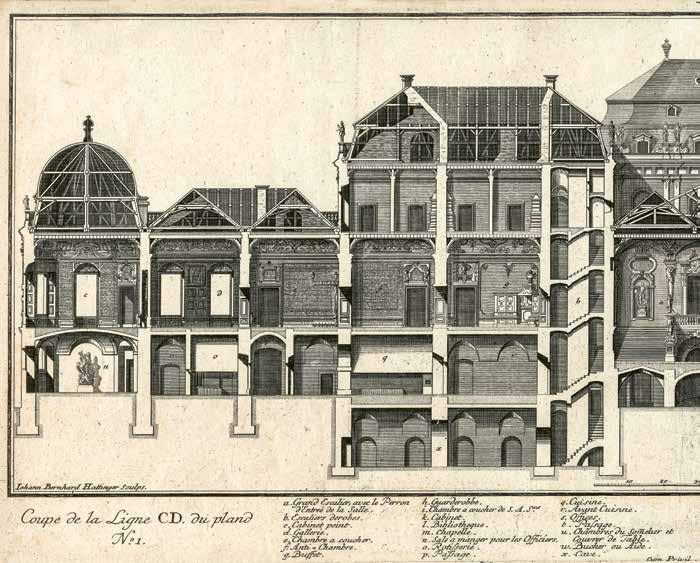
In 1697, Prince Eugene of Savoy started acquiring plots of land on Rennweg and initially commissioned extensive groundworks. Dominique Girard was subsequently placed in charge of designing the gardens, while the two palaces and their annexes were created by Johann Lucas von Hildebrandt (→ p. 23) Based on his plans, the Lower Belvedere was built between 1712 and 1717, followed by construction of the Upper Belvedere from 1717 to 1723. After Prince Eugene’s death, the entire estate was inherited by his niece, Princess Victoria of Savoy. In 1752 she sold the Belvedere and the Winter Palace on Himmelpfortgasse (→ p. 49, 4 ) to the monarch, Maria Theresa. Thus it became imperial and, eventually, public property.
Both the gardens and the palaces were lavishly furnished and decorated to reflect the interests of their owner (→ p. 24) The orangeries next to the Lower Belvedere housed a multitude of exotic plants, which were greatly admired. Prince Eugene devoted particular attention to the construction of his aviary and menagerie, which he filled with birds and animals often acquired with the help of international connections the successful general had gained during his military career. Some of the garden sculptures, as well as the upper and lower cascade — which originally had its own separate water main have survived to this day.
At the heart of the Lower Belvedere is the corps de logis with its central Marble Hall, preserved in all its original splendor. The hall is adorned with a ceiling fresco by Martino Altomonte, depicting Apollo in his sun chariot as the leader of the Muses, an allusion to Prince Eugene’s art-loving side (→ p. 51, fig. 2) . Further state rooms are located in the palace’s west wing : the Hall of Grotesques, the Marble Gallery, and, finally, the Gold Cabinet, the sumptuous décor of which was added later, under Maria Theresa.
Originally entered from the mezzanine floor to the south, several rooms in the Upper Belvedere have also been passed down to us in their initial design. On the bel étage, we again encounter a breathtaking Marble Hall with a ceiling fresco by Carlo Innocenzo Carlone, exalting the eternal glory of Prince Eugene accompanied by the princely virtues. Carlone also painted the frescoes in the hall named after him that adjoins the Sala Terrena (→ p. 35) , as well as in the Palace Chapel. The latter has been preserved in its original appearance, complete with an altarpiece by Francesco Solimena depicting the Resurrection of Christ, a masterpiece of Neapolitan Baroque painting (→ p. 36)
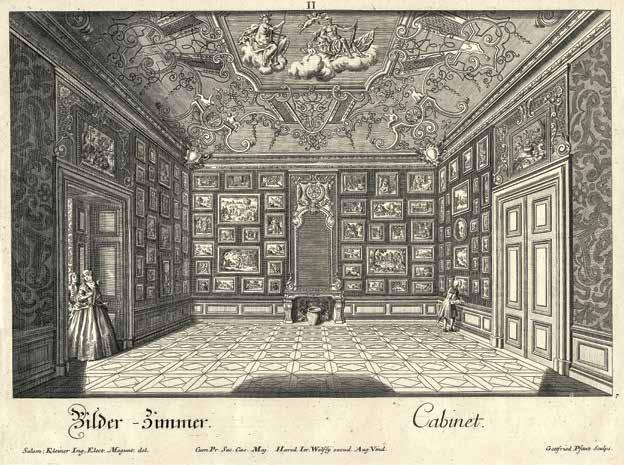
In the room adjoining to the prince’s bedchamber are several exquisite pieces of small paintings, and in the next chamber is a very precious chandelier of rock crystal, valued at twenty thousand guldens. Here is also a Dutch piece of painting, which cost thirteen thousand guldens, representing an old woman on her death-bed, with her daughter on her knee taking her leave of her, while her maid is administering a medicine in a spoon, and the physician looking at the urine.
Mondays are usually very crowded and busy. Plenty of folk from the lower classes, apprentices taking the Monday off, and even menial servant girls with children on their arms, enjoy spending an afternoon in the picture gallery. I would like this to change. Children are dangerous for the gallery : they touch the most precious pieces with their grubby fingers. Why would children come to a gallery at all ? I believe it would be quite feasible, without incommoding visitors too much, to ban children and other base elements. After all, an art collection is not a puppet show, and it is clear that these people do not appreciate the pictures any more than if, out of boredom, they were to visit a Savoyard and his peepshow.
Johann Pezzl, Skizze von Wien : Drittes Heft , Vienna 1787, pp. 441–42.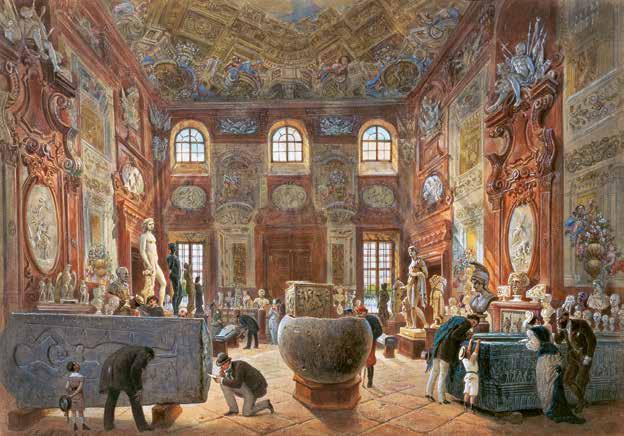

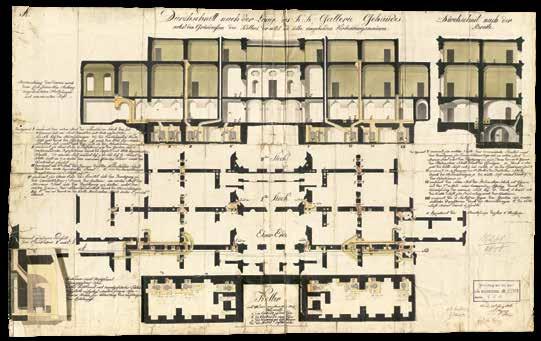 Alice Hoppe-Harnoncourt
Alice Hoppe-Harnoncourt
Like the palace interior itself, the paintings in the Imperial Picture Gallery had suffered considerable damage during the Napoleonic Wars (→ p. 133, 9 ) . Joseph Rebell, the newly appointed director, consequently devised a restoration concept that, for the first time, included a systematic program of conservation measures. Stage one involved setting up a laboratory for “mechanical operations” such as cleaning and relining, and from 1826 also cradling (the supports were thinned and then strengthened using glued-on wood battens and flexible sliding bars). Furthermore, in order to stabilize the environment of the gallery building, structural modifications were made in 1826, such as adding glass doors to seal off the entrance hall. A hot-air heating system was also installed to keep the gallery rooms at a more constant temperature, replacing the individual wood-burning stoves with a flow of warm air heated in the basement (fig. 1) . Although this succeeded as intended in drying out the building, it turned out to have serious repercussions for the panel paintings, as director Peter Krafft observed in 1829 : “Since Your Excellency ordered that […] the panel paintings of the German and Netherlandish schools should be cradled in the course of this summer to avoid the danger of warping and cracking due to the Meissner heating system at the Imperial-Royal Gallery,” he requested a raise in the budget. He gave assurance that “with these preventative measures, the heating system will cause no further harm.” 1
In the Enlightenment era, European aristocrats began reorganizing the collections they had accumulated in their palaces over the centuries. Two reasons lay behind this laborious endeavor. On the one hand, the artworks and curiosities were no longer seen merely as precious marvels, acquired to be adored, they were now perceived as objects that inspired aesthetic sensibilities and whose study could reveal scientific insights. On the other hand, an audience emerged in the eighteenth century that increasingly expressed the desire — and eventually the demand — to participate in the contemplation and exploration of these collections. It was in the context of this social, cultural, and educational process that the institution of the museum was born.
While experts worked on developing criteria for their display, it was necessary to find locations suitable for housing the collections that were also accessible for a growing audience. As a result of the completion of monumental museum buildings during the nineteenth century, the emergence of museums is often attributed to this period. In reality, however, the museum, from initial experiments to successful models such as the Belvedere in Vienna, is the intellectual product of the Enlightenment of the eighteenth century.
In the early history of this institution, a variety of ideas were being discussed at the princely courts, which, thanks to their international connections, spread rapidly. Usually, the principal aim was to consolidate and redistribute the collections that were scattered across various palaces. Some early new buildings also emerged, for instance in Düsseldorf, Potsdam, and Kassel. At the Académie d’architecture in Paris students drew up the first fanciful, often somewhat megalomaniacal designs for museum buildings.
to tolerate being alone in the gallery rooms for long periods of time, even more since this feeling of solitude also deprives him of a good night’s sleep.
On Saturday morning, my daughter Gertrud paid a visit to the Modern Gallery. While passing the gas heater in the Klinger Room, her dress caught fire. The attendant who came to help then revealed that the same heater had caused the same thing to happen with a lady’s dress the previous year.
He [says he is] unable […]Letter from Karl Cehak concerning the attendant Rudolf Reich, AdB, Building Inspectorate of the Imperial-Royal Technical University Vienna, Zl. 48/1904
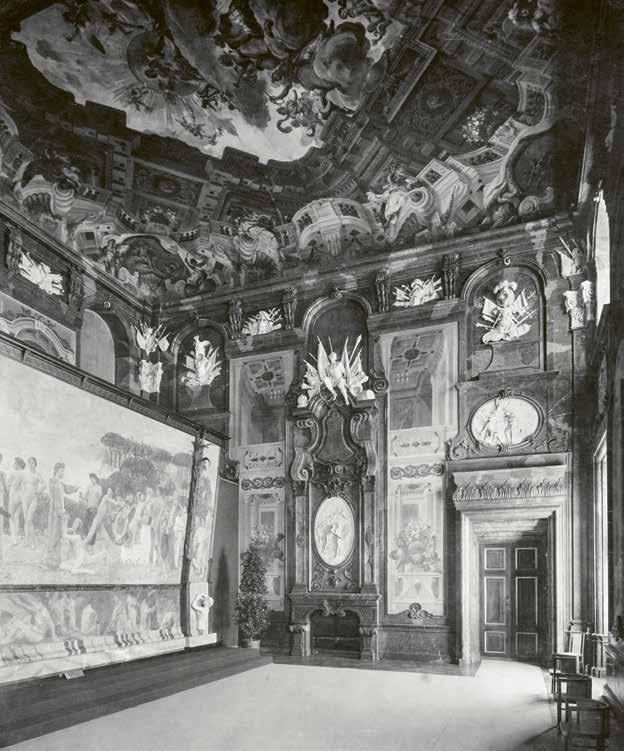
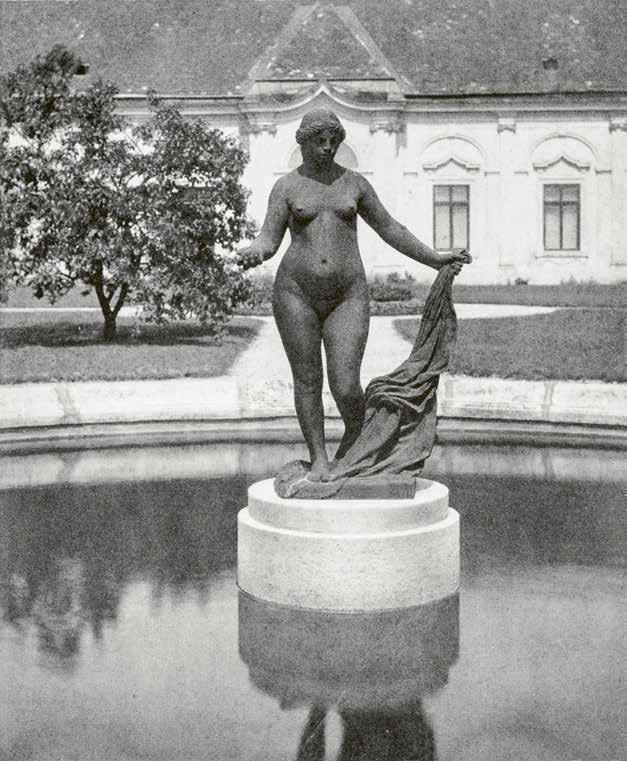
“At last, the scarcely believable situation that, until now, Austria’s ‘Modern Gallery’ has not owned a single representative work by Austria’s greatest master has been rectified. It was left to Marchet’s ministry to overcome the ‘Klimt fear’ that had for years prevailed in certain well-meaning bureaucratic circles.” 1 With these words, Berta Zuckerkandl announced on August 4, 1908, in the Wiener Allgemeine Zeitung that Gustav Klimt’s painting Lovers had been purchased for the recently founded Modern Gallery.
In 1908, on the site where the Konzerthaus and Akademietheater are now located, the so-called Klimt Group, led by Gustav Klimt, Josef Hoffmann, Koloman Moser, and Carl Moll, had a temporary exhibition building erected for the Kunstschau. Planned by Josef Hoffmann, the exhibition pavilion accommodated the works of 180 artists. Room 22 was designed by Koloman Moser and devoted entirely to Gustav Klimt. It featured sixteen paintings by Klimt, including the golden Portrait of Adele Bloch-Bauer I of 1907, Three Ages of Woman , Danaë , Water Serpents , and several landscapes. In a prominent position, opposite the entrance to this “Klimt church of new art,” 2 the now iconic painting Lovers was shown for the first time (fig. 1) . Only ten days after the exhibition’s opening on June 10, 1908, the committee of the Modern Gallery Vienna decided to purchase the painting. That same month, the art commission of the German department at the Modern Gallery in Prague also expressed an interest. In July, Norbert Wien, secretary of the
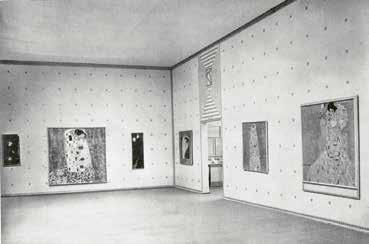
By using the Belvedere complex in its entirety, it was possible for the first time to develop a coherent concept for the museum, now (since 1921) called the Austrian Gallery. Bruno Grimschitz (→ p. 255, fig. 1) , long-standing member of staff to Haberditzl, explained it as follows : “Whereas the large rooms of the Baroque Museum with their exaggerated pomp reflect the aristocratic lifestyle of the feudalist eighteenth century, and the rooms in the Upper Belvedere clearly underscore the more intimate dimension of nineteenth-century bourgeois life and art, the Modern Gallery aims to create a space that matches the artistic creations of the most recent generation : a neutral, pragmatic setting, without ornamentation, without any particular mood, providing an anonymous background in the sense of a rarified exhibition hall that represents a contemporary passageway on the artwork’s path from artist to owner.” 31 The difference compared to the “first” Modern Gallery could not have been greater. The puritanical strictness of the exhibition set-up was striking — attributable, in addition to the neutral framework, to the widely spaced arrangement of the pictures. With almost the same number of rooms as the former gallery, the number of exhibits was reduced by more than a quarter, with eleven of the thirty-one sculptures being shown in the Privy Garden (→ p. 158 and fig. 7) . Many of the works on paper from the original display had been transferred to the Albertina as part of the museum reform. The entrance hall featured the tapestry Landscape with Herons by Robin Christian Andersen (fig. 8) . The walls were limewashed in strong, clear colors : white, sulfur yellow, glossy aluminum gray, dark blue, dark brown, and orange. Rubber instead of wood flooring emphasized modernity in the choice of materials. The only restrained highlights were the brightly polished brass doorframes. There were no explanatory wall texts either. Not even the Museum of Modern Art in New York, which opened in the same year, could offer a more radical exhibition design (fig. 9) . The German art dealer Karl Haberstock wrote to the Belvedere : “I can assure you that I know of no modern gallery that feels so harmonious. The ideas you have employed here are sure to become era-defining for our museum landscape.” 32
CHRISTIAN HUEMER31 Grimschitz 1929, pp. 482–83.
32 Karl Haberstock to the director of the Austrian State Gallery, September 19, 1929, AdB, Zl. 561/1929.
The end of World War I saw the collapse of the Habsburg monarchy and the declaration in November 1918 of the Republic of German-Austria. Both the victorious powers and the successor states of the former monarchy demanded the appropriation of art objects owned by the house of Habsburg-Lorraine. A law was therefore hurriedly adopted prohibiting the export and sale of objects of historical, artistic, or cultural significance. One week after the abdication of Emperor Charles I, the former imperial museums came under state control. It was at this time that the art historian Hans Tietze (fig. 1) , an official at the Central Commission for Monument Protection, began his campaign, expressed in numerous articles, for the preservation of Austria’s art assets and a reorganization of state museums. 1 His protest was also aimed at the government itself, which had proposed to support the suffering populace, particularly in the starvation winters immediately after the war, by selling off art objects.
In 1919, in his position at the Ministry of Internal Affairs and Education as commissar responsible for the protection of German-Austrian science and art collections, Tietze began to draw up a concept for reforming the Austrian museum system with the aim of merging the imperial collections and the state-owned
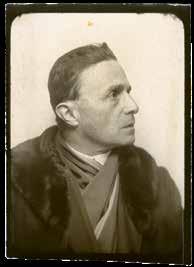
↑
First Vienna Arbitration Award in the Upper Belvedere ; from l. to r., František Chvalkovský, Galeazzo Ciano, Joachim von Ribbentrop, and Koloman von Kánya, in the background Self-Portrait with Cigarette and Orpheus and Eurydice by Anselm Feuerbach, November 2, 1938
→ p. 231
From l. to r. : Adolf Hitler, Galeazzo Ciano, Saburō Kurusu, Pál Teleki von Szék, Stefan von Csáky, and Joachim von Ribbentrop at the reception in the Upper Belvedere on the occasion of Hungary’s accession to the Tripartite Pact between the German Reich, Japan, and Italy, November 20, 1940
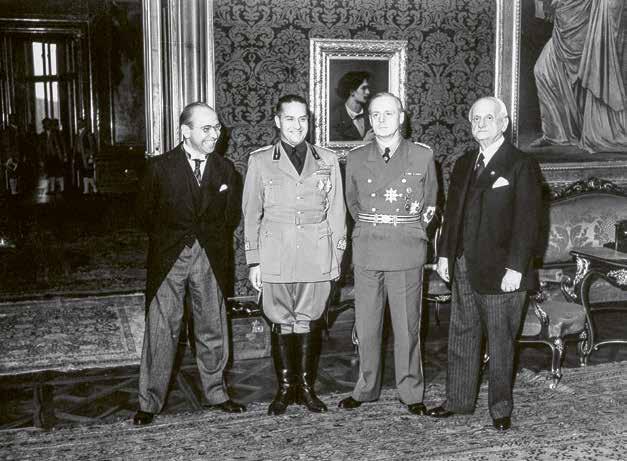
After the annexation of Austria to the German Reich in March 1938, the laws already existing in Germany were introduced in Austria. Among them was the Reich Chamber of Culture Law, which had defined cultural policy in Germany since 1933. The forced alignment of all artists with the National Socialist ideology marked the start of the Nazification and state control of German culture. The Reich Chamber of Fine Arts (RdbK) was one of the seven sections (literature, film, music, theater, press, and radio were the others) of the Reich Chamber of Culture, which was answerable to the Reich Minister of Public Enlightenment and Propaganda, Joseph Goebbels. The RdbK, headed between 1933 and 1945 by Eugen Hönig, Adolf Ziegler, and Wilhelm Kreis, was the central administrative body for artists in the Third Reich. Membership in it was a prerequisite for being allowed to practice art. Applicants were subject to a strict admission procedure that verified not only their artistic ability but also their “origin” and political reliability. Artists of Jewish origin, political opponents, and representatives of a modern-liberal approach to art had no chance of being admitted. Those whose applications had been rejected were banned from working, and compliance with this ban was enforced by the Gestapo. Exemptions were rare. In this way, the Nazi
regime kept a tight control on the arts and was able to shape the nation’s creative output in accordance with its ideology.
As in the German Reich, RdbK offices were established in the various Gaus (districts) in the “Ostmark” (the Nazi name for Austria). In April 1938, Gauleiter Josef Bürckel appointed the painter and Künstlerhaus president Leopold Blauensteiner (fig. 1) as “leader of all fine arts institutions.”
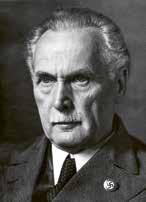
In August 1939, Blauensteiner was put in charge of the Vienna office of the RdbK. Its first director until 1944 was the architect and painter Marcel Kammerer, who was succeeded by the writer Franz Schlögel. Blauensteiner was assisted by representatives of the various disciplines, including the painter Igo Pötsch, the sculptor Ferdinand Opitz, and the architect Robert Örley. The office was initially located in the Künstlerhaus, but in 1939 moved to the premises of the Reich Propaganda Department in the “Aryanized” Palais Epstein ( Reisnerstrasse 40, 3rd district) and then, shortly before the end of the war, to the Trattnerhof (Graben, 1st district).
Blauensteiner was one of the most powerful National Socialist culture functionaries in Vienna. His tasks included overseeing the admission procedure, which required close liaison with the Vienna Gau NSDAP administration, the Gestapo, and the RdbK in Berlin. Art exhibitions had to be approved by him, and he also intervened against “degenerate art” (→ p. 221, 16 ) , monitored prices on the art market, sat on competition juries, and approved travel, financial subsidies, and material allocations. He was tried after the war by a Volksgericht (people’s court).
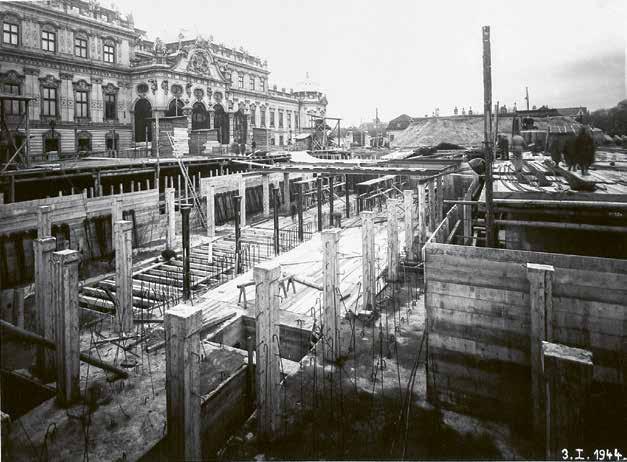
The undersigned director also reports that there are 13 tonnes of coke, and with minimal heating of the Upper Belvedere palace the said exhibitions can remain open until the beginning of March. Even if it does close, it must be ensured that the temperature does not drop below +6 degrees, so as to protect the precious artworks of the gallery and Prussian palaces from damage.
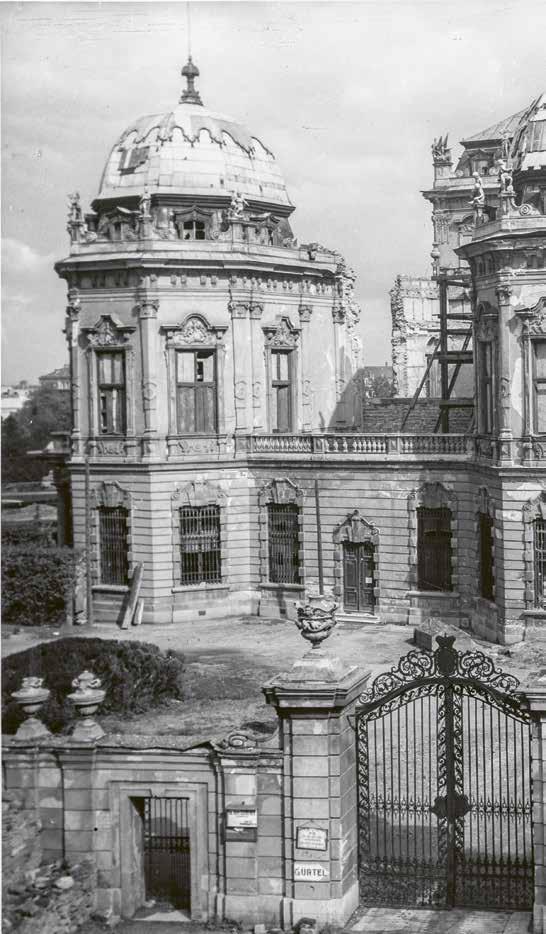 Upper Belvedere, war damage on the west side, July 1945
Upper Belvedere, war damage on the west side, July 1945
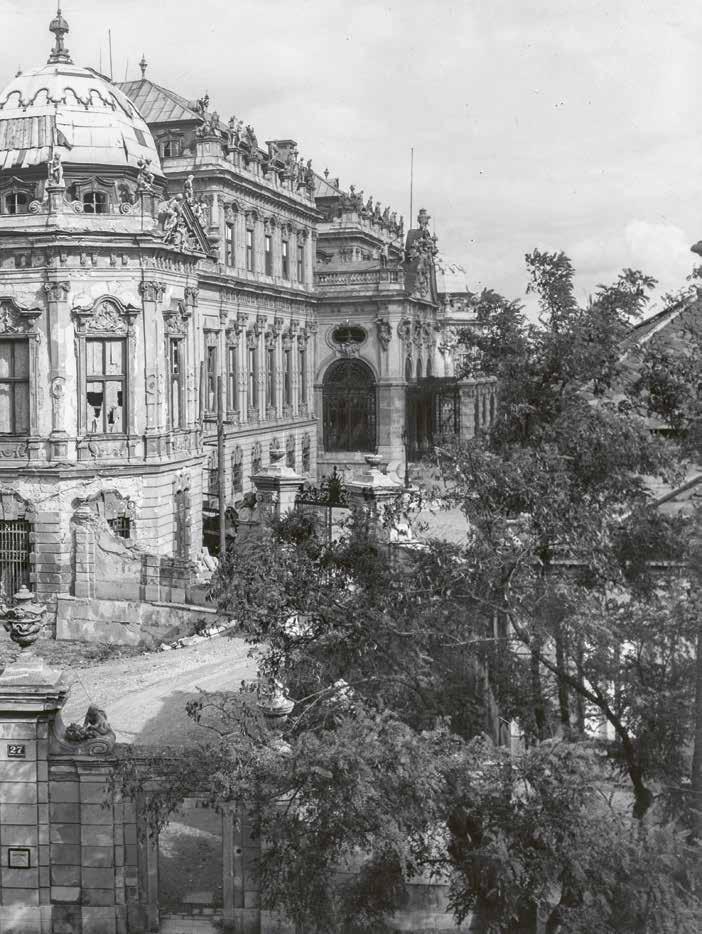
mained for a long time beyond the range of Allied bombers. The first air raid on Vienna was not until March 17, 1944. For that reason, art dealers from the “Altreich” transferred their businesses to Vienna. In October 1943, Hans W. Lange from Berlin held two auctions in the Dorotheum, the largest auction house in the German Reich. It bought paintings in France and the Netherlands and was one of the most important sources of works for the planned “Führermuseum” in Linz. The art market in general flourished until the last months of the war, with auctions taking place in Vienna as late as December 1944.
1 Weidinger 2017.
2 For details of art dealerships and persons involved in it, see the entries in the Lexicon of Austrian Provenance Research , https://www .lexikon-provenienz forschung.org/en (accessed on October 19, 2022).
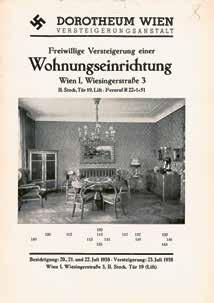
3 www.provenienzfor schung.gv.at/beirats beschluesse/Gotthilf_ Ernst_2007-06-01.pdf (accessed on November 16, 2022).

abundance,” as Hans Sedlmayr put it,45 was removed from office in October 1945 and permanently retired with effect from October 31, 1947. The fact that this “greatest abundance” was also directly linked to the “Aryanization” of Jewish art collections 46 by the Nazi regime should not go unmentioned.
Bruno
The painting was part of the art collection of Reich foreign minister and industrialist Walther Rathenau, a patron of modern German art, who was assassinated in Berlin in 1922. The Austrian Gallery acquired Corinth’s nude and a double portrait by Edvard Munch from Rathenau’s estate during the Nazi period.
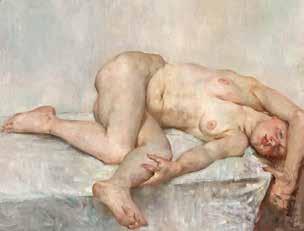


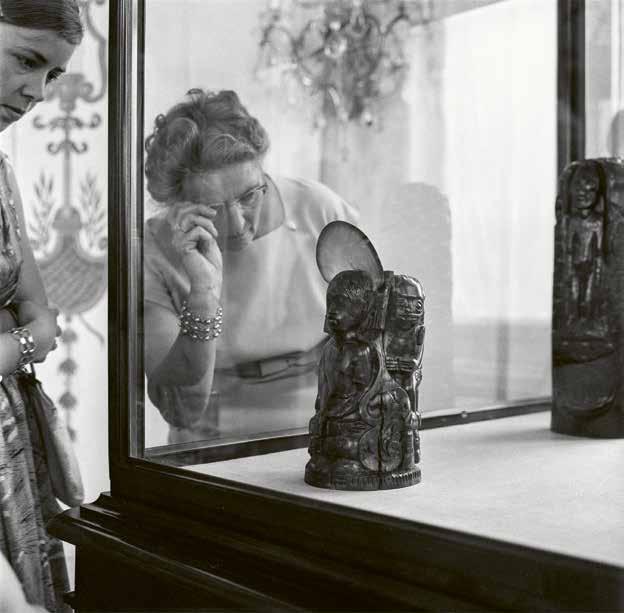
I am more or less familiar with every gallery in Europe and would like to say that, even with less internationally renowned names than other galleries are able to sport, you are able to make a surprisingly good overall impression. […] The plaques with the names of each painting and its painter, albeit coherent and attractive in themselves, are consistently positioned below the pictures and thus in some cases barely visible and very difficult to read.
The Klimt exhibition with the juxtapositions of portraits by famous European artists is wonderful — on one condition : that no more than around five hundred visitors should be allowed into the exhibition spaces at once. Because of the crowds on New Year’s Eve 2000, our visit was an absolute HORROR and not worth the entry charge. Every thermal spa, every cinema, concert hall, even ski pistes, show a reasonable level of restraint on the part of the organizers. So why not also in your gallery ?
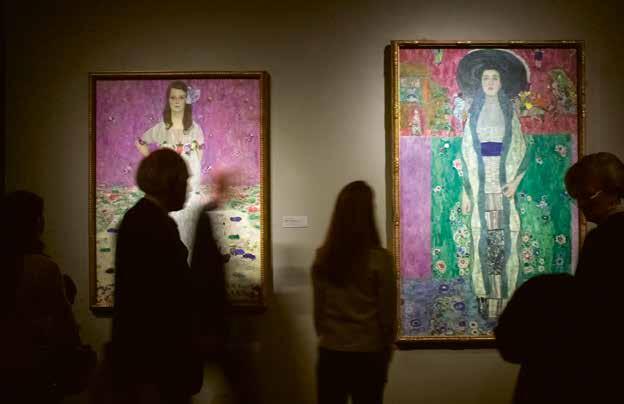
↑ The annual summer festival at the Belvedere with Open Mic The public microphone with Schudini The Sensitive , July 15, 2022.
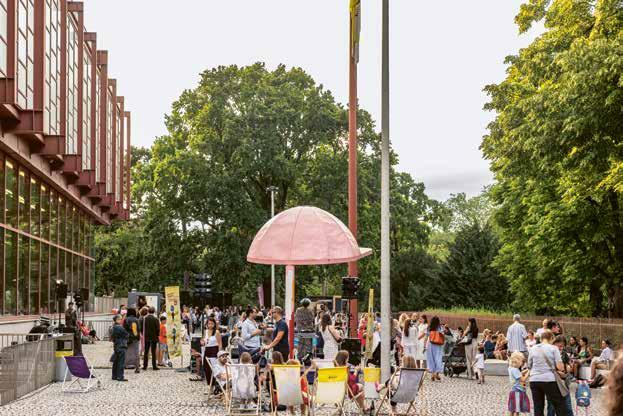
The oversized pink cap in the center belongs to the sculpture B-Girls, Go ! by the artist Maruša Sagadin and forms a stage with a purple wooden deck.
→ p. 309
Rainbow flags outside the Belvedere 21 to mark the “Queering the Belvedere” public program, 2021, Belvedere, Vienna
The neighborhood of the Belvedere 21 located between the Belvedere Palace, Schweizergarten, and the Arsenal (fig. 1) — is one of the largest inner-urban redevelopment areas in Vienna. In preparation for a construction project on a comparable scale to Berlin’s Potsdamer Platz in the 1990s, the S-Bahn station Südbahnhof (South Station) was developed and renamed Quartier Belvedere in December 2012. In December 2019, public transport connections were improved when the D tram line was extended from the Hauptbahnhof (Central Station) via the Sonnwendviertel to Absberggasse in the 10th district. In the intervening period, the twenty-five-hectare site of the former Südbahnhof was redeveloped, including construction of the new Central Station which opened in October 2014 and was fully opera tional by December 2015 and two new urban quarters : the Belvedere Quarter and the Sonnwendviertel (fig. 2)
The Vienna Südbahnhof has a long history as a hub connecting east and west, south and north. As far back as the nineteenth century, this area was associated with migration, when, during the construction of the Ringstrasse, laborers from Bohemia and Moravia arrived in the city to work in the brickworks on Wienerberg in the south of Vienna. From the early 1950s to the mid1960s, workers from Turkey and the former Yugoslavia came to Austria through recruitment agreements. They often settled in Favoriten, Vienna’s 10th district, which borders the station. In the 1990s, the Südbahnhof became associated with refugees fleeing the wars in the former Yugoslavia. While, during those years, refugees often disembarked
at the bus terminal, by 2015, refugees from Syria were already arriving at the new Central Station and continuing their journey from there. These days, the station serves as a first port of call for refugees from Ukraine.
The Belvedere Quarter is a mixeduse development with office, business, and residential units. It includes the office buildings of Erste Group, Canetti Tower, The Icon Vienna, the Quartier Belvedere Central spanning six building plots alone and the apartment blocks Bel & Main Residences, BelView Apartments, and Parkapartments am Belvedere on Arsenalstrasse. The Sonnwendviertel, located behind this quarter, is a new neighborhood with five thousand apartments, providing homes for thirteen thousand people, equivalent to the population of a medium-sized Austrian town. Many partly self-organized housing and community projects have settled here, all of which have community spaces, including some that offer cultural activities such as Gleis 21, Grätzelmixer, and CAPE 10 or, like Bikes and Rails, run a community café.
These changes to its urban environment have resulted in a repositioning of the Belvedere 21 in the city. Today it is situated at the heart of a cultural axis extending from the Wien Museum on Karlsplatz through the Belvedere Quarter and the Arsenal as far as the 10th district with the Brotfabrik cultural center. This new positioning was one of the reasons why, in 2018, the Belvedere was the first federal museum to establish the post of Curator for Community Outreach 1 at the Belvedere 21 as part of its new self-understanding as an integral participant in this ongoing urban transformation.
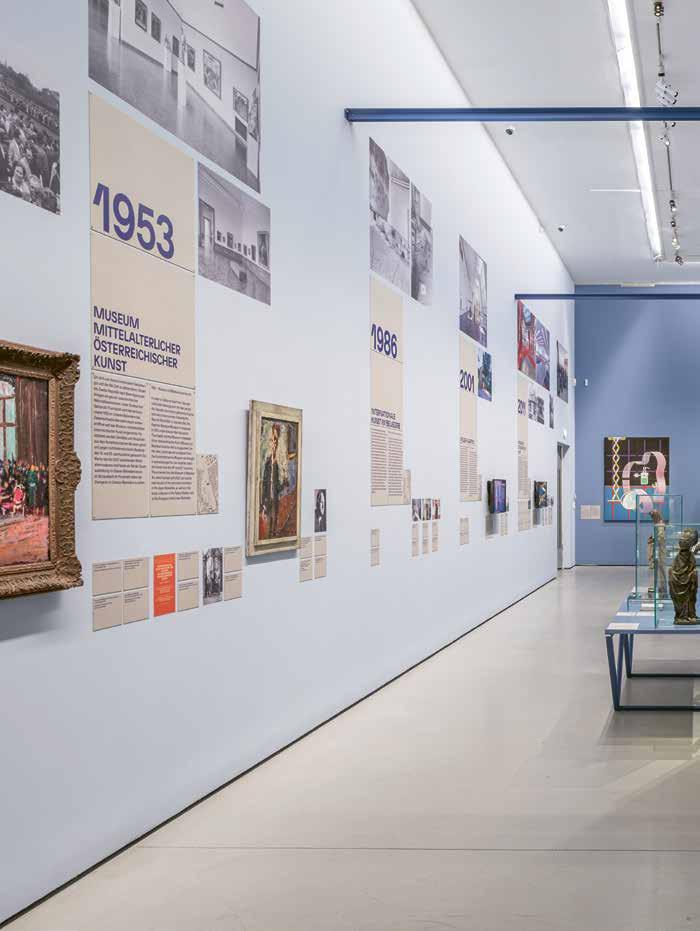
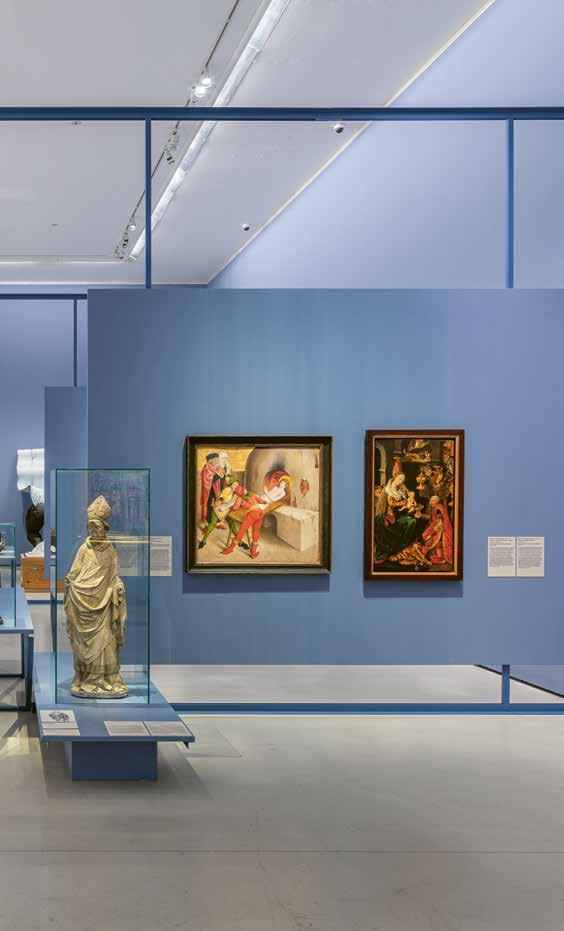
1 Neuwirth 1951.
2 For more on the role of Fritz Novotny as custodian and later director of the Austrian Gallery, see Katinka GratzerBaumgärtner, “Fritz Novotny,” in Lexikon der österreichischen Provenienzforschung , July 2019, https://www.lexikon-provenienz forschung.org/novotny-fritz ( accessed on January 16, 2023).
3 See Karl Garzarolli-Thurnlackh, speech for Minister Illig, opening of the Upper Belvedere, July 17, 1954, AdB, Zl. 281/1954.
“Heavy sigh in view of the new acquisitions : ‘What about the Modern Gallery ?’” 1 is the headline introducing an article by artist Arnulf Neuwirth in the Mitteilungen des Art Club Wien in 1951, taking up an issue that runs through the history of this institution from its beginnings right up to the 2010s. It is as much about the search for a suitable location for contemporary art of the time as about its relevance in the institution’s programmatic direction, and not least the question of whether — and how — to place this work in an international context. Contemporaneity and internationality — two key elements in the founding story of the Modern Gallery — serve as leitmotifs in this essay, putting into perspective the Austrian Gallery’s programmatic development from 1945 to the present. In terms of substantive focus, associated identificatory potential, and identity-forming functions — and, not least, the actors involved and their decisions regarding institutional, collection, and exhibition policy — what transpires is a development characterized by contradictions, ambivalences, and ruptures, but also continuities.
Immediately after the war, and following the dismissal of Bruno Grimschitz, the custodian Fritz Novotny (→ pp. 371–72) , 2 appointed interim director from 1945 to 1947, had very limited room for action. Due to the lack of construction materials, the roofs of both palaces, which had been badly damaged in the bombings of autumn 1944 and February 1945 (→ pp. 237–39) , were only provisionally patched up with tarpaulins ; at least the restoration of the ruined grounds could be tackled, however.3 Although exhibitions in the buildings of the Belvedere remained out of the question for years, as soon as September 1945, Novotny, in collaboration with the general director of the Staatliche Kunstsammlungen Wiens (State Art
1809
Napoleonische Kriege, mehrfache Evakuierung der kaiserlichen Sammlungen, Abtransport von etwa vierhundert Gemälden nach Frankreich (später Rückführung).
Ab 1813
Aufstellung von Kunstkammerobjekten und Rüstungen (Ambraser Sammlung) sowie Antiken im Unteren Belvedere.
1824–28
Direktion Joseph Rebell (Abb. 5)

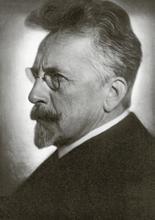
1829–56
Direktion Peter Krafft (Abb. 6)
1857–71
Direktion Erasmus von Engert (Abb. 7)
1871–92
Direktion Eduard Ritter von Engerth (Abb. 8) .
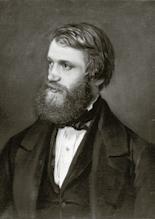
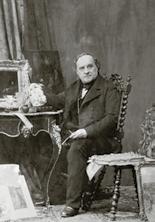
Eröffnung des neu errichteten Kunsthistorischen Museums, das Belvedere steht zeitweise leer.
Umbau des Oberen Belvedere zu Wohnzwecken für Thronfolger Erzherzog Franz Ferdinand und seine Familie, Architekt : Emil Ritter von Förster.
Die 1903 im Unteren Belvedere eröffnete Moderne Galerie präsentiert die neuere österreichische Kunst im internationalen Kontext. Mit der Erweiterung und der Umbenennung in k. k. Österreichische Staatsgalerie 1911/12 soll die Entwicklung der österreichischen Kunst vom Mittelalter bis zur Gegenwart gezeigt werden. Nach dem Zusammenbruch der Monarchie werden im Zuge der Museumsreform ab 1919 die Sammlungen neu strukturiert und ihre Präsentation auf beide Belvedere-Schlösser ausgedehnt.
Im Zweiten Weltkrieg sind einzelne Sammlungsteile bis August 1944 geöffnet. Die Bestände werden in Bergungsdepots ausgelagert. Erst 1953/54 sind alle Kriegsschäden behoben, und das Museum kann wiedereröffnet werden. Heute definiert sich das Belvedere als ein diskursiver Ort, an dem gesammelt, geforscht, bewahrt, ausgestellt und vermittelt wird.
1899
Architekturentwürfe Otto Wagners für eine „Galerie für Werke der Kunst unserer Zeit“.
1900
Gründung eines Komitees zur Errichtung einer Modernen Galerie, dem unter ande ren die Künstler Edmund Hellmer, Carl Moll und Otto Wagner angehören.
1903
Eröffnung der Modernen Galerie als staatliches Museum mit der Gründungsintention der Präsentation österreichischer Kunst im internationalen Kontext. Provisorische Einrichtung im Unteren Belvedere.
1908
Gustav Klimts Gemälde Der Kuss ( Liebespaar) wird für die Moderne Galerie erworben (→ S. 159, 11 )
1909
Friedrich Dörnhöffer, Kustos des Kupferstichkabinetts der k. k. Hofbibliothek, wird erster Direktor der Modernen Galerie (Abb. 9) .
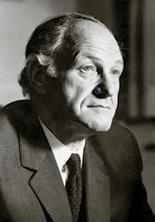
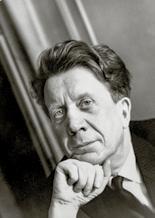
1911/12
Umbenennung in k. k. Österreichische Staatsgalerie mit erweitertem Sammlungsanspruch, die Entwicklung der österreichischen Kunst vom Mittelalter bis zur Gegenwart zu präsentieren. Gründung des Österreichischen Staatsgalerie vereins.
1913
Architekturentwürfe Otto Wagners für ein neu zu bauendes „Haus der Kunst“.
1914
Ermordung von Franz Ferdinand und seiner Gemahlin Sophie am 28. Juni in Sarajevo. Ausbruch des Ersten Weltkriegs.
1915
Der Leiter der Kupferstichsammlung der k. k. Hof bibliothek Franz Martin Haberditzl wird Direktor der k. k. Österreichischen Staatsgalerie (Abb. 10) .
1917/18
Erzherzog Maximilian Eugen, der Bruder des letzten Kaisers von Österreich Karl I., wohnt mit seiner Familie im Oberen Belvedere.
1918
Ende des Ersten Weltkriegs. In diesem Jahr sterben Gustav Klimt, Egon Schiele, Koloman Moser, Ferdinand Hodler und Otto Wagner.
Als Folge der Museumsreform nach Hans Tietze (→ S. 187, 13 ) werden die Sammlungen in einer erweiterten Präsentation im Oberen und im Unteren Belvedere gezeigt.
1921
Umbenennung in Österreichische Galerie.
1923

Eröffnung des Barockmuseums im Unteren Belvedere.
1924
Die Galerie des 19. Jahrhunderts wird im Oberen Belvedere eröffnet.
1929
Die Moderne Galerie als Sammlung der Kunst des 20. Jahrhunderts wird in der Orangerie eröffnet. Im Kammergarten wird ein Skulpturengarten eingerichtet.
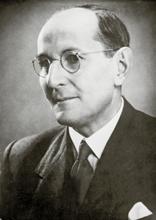
Das Belvedere.
300 Jahre Ort der Kunst
Publikation
Herausgeber*innen : Stella Rollig, Christian Huemer
Autor*innen :
Johanna Aufreiter, Björn Blauensteiner, Brigitte BorchhardtBirbaumer, Thomas DaCosta
Kaufmann, Christiane Erharter, Nora Fischer, Anna Frasca-Rath, Antoinette Friedenthal, Martin Fritz, Thomas W. Gaehtgens, Sabine Grabner, Katinka GratzerBaumgärtner, Cäcilia Henrichs, Alice Hoppe-Harnoncourt, Christian Huemer, Georg Lechner, Stefan
Lehner, Gernot Mayer, Monika
Mayer, Sabine Plakolm-Forsthuber, Georg Plattner, Matthew Rampley, Luise Reitstätter, Stella Rollig, Claudia Slanar, Franz Smola, Nora Sternfeld, Silvia Tammaro, Wolfgang Ullrich, Leonhard Weidinger, Christian Witt-Dörring, Luisa Ziaja, Christoph Zuschlag
Konzeption :
Christian Huemer
Redaktionsteam :
Christian Huemer, Eva Lahnsteiner
→ Kapitel 1 : Georg Lechner
→ Kapitel 2 : Georg Lechner, Sabine Grabner
→ Kapitel 3 : Stefan Lehner, Monika Mayer
→ Kapitel 4 : Monika Mayer
→ Kapitel 5 : Luisa Ziaja, Monika Mayer
Bildredaktion :
Eva Lahnsteiner, Stefan Lehner, Carmen Müller
Grafische Gestaltung :
Marie Artaker
Designassistenz und Satz : Kevin Mitrega, Schriftloesung
Übersetzung (Englisch –
Deutsch) :
Wilfried Prantner (DaCosta
Kaufmann, Rampley)
Lektorat :
Katharina Sacken
Personenregister :
Jutta Mühlenberg
Publikationsmanagement & Herstellung :
Eva Lahnsteiner, Beba Pikall-Kotyza
Content & Production Editor
für den Verlag :
Katharina Holas, Birkhäuser Verlag, A-Wien
Bildbearbeitung :
Pixelstorm, Wien
Druck und Bindung :
Gugler GmbH, Melk/Donau
Papier : Surbalin seda & glatt mintgrün, 135 g/m², Munken Lynx, 120 g/m², Pergraphica Timid Grey, 120 g/m²
Schriften : GT Super Text, Korpus Grotesk, Apoc, Lithops
Dieser Forschungsband erscheint begleitend zur Ausstellung Das Belvedere. 300 Jahre Ort der Kunst vom 2. Dezember 2022 bis 7. Jänner 2024 in der Orangerie des Belvedere, Wien.
Kurator*innen der Ausstellung : Björn Blauensteiner, Sabine Grabner, Kerstin Jesse (Konzeptmitarbeit), Alexander Klee, Georg Lechner, Stefan Lehner, Monika Mayer und Luisa Ziaja
Generaldirektorin, wissenschaftliche Geschäftsführerin : Stella Rollig
Wirtschaftlicher Geschäftsführer : Wolfgang Bergmann Ausstellungsmanagement und Sammlungsverwaltung : Stephan Pumberger Ausstellungsproduktion : Sarah Kronschläger Ausstellungsarchitektur : studio-itzo, Wien Chef kuratorin :
Luisa Ziaja Kunstvermittlung :
Michaela Höß
Kommunikation & Marketing : Katharina Steinbrecher Besucher*innenservice : Margarete Stechl Research Center : Christian Huemer Restaurierung : Stefanie Jahn
Belvedere
Prinz Eugen-Straße 27 1030 Wien www.belvedere.at
Alle Rechte vorbehalten Gedruckt in Österreich
Library of Congress Control Number : 2023931558
Bibliografische Information der Deutschen Nationalbibliothek : Die Deutsche Nationalbibliothek verzeichnet diese Publikation in der Deutschen Nationalbibliografie ; detaillierte bibliografische Daten sind im Internet über http://dnb. dnb.de abrufbar.
Dieses Werk ist urheberrechtlich geschützt. Die dadurch begründeten Rechte, insbesondere die der Übersetzung, des Nachdrucks, des Vortrags, der Entnahme von Abbildungen und Tabellen, der Funksendung, der Mikroverfilmung oder der Vervielfältigung auf anderen Wegen und der Speicherung in Datenverarbeitungsanlagen, bleiben, auch bei nur auszugsweiser Verwertung, vorbehalten. Eine Vervielfältigung dieses Werkes oder von Teilen dieses Werkes ist auch im Einzelfall nur in den Grenzen der gesetzlichen Bestimmungen des Urheberrechtsgesetzes in der jeweils geltenden Fassung zulässig. Sie ist grundsätzlich vergütungspflichtig. Zuwiderhandlungen unterliegen den Strafbestimmungen des Urheberrechts.
ISBN 978-3-11-118620-7 (deutsche Verlagsauf lage)
e-ISBN (PDF) 978-3-11-118660-3
ISBN 978-3-11-118631-3 (englische Verlagsauf lage)
ISBN 978-3-903327-45-0 (deutsche Museumsauf lage)
ISBN 978-3-903327-46-7 (englische Museumsauf lage)
© 2023 Belvedere, Wien, Walter de Gruyter GmbH, Berlin/Boston, Künstler*innen und Autor*innen
www.degruyter.com
The Belvedere in Vienna epitomizes the changes that have taken place over the course of three centuries in the concept of what constitutes a museum. Originally built by Prince Eugene of Savoy to enhance his prestige as a prince, under Maria Theresa the Upper Belvedere became one of the world’s first public museums. The idea of presenting Austrian art in an international context, which in 1903 motivated the establishment of the Modern Gallery in the Lower Belvedere, remains the key objective of this worldfamous cultural institution.
In this critical homage, renowned authors explore enduring questions that transcend the different epochs, such as : What ordering concepts are evident in art presentation ? How contemporary were these presentations in an international context ? What kind of public were they aimed at ?
Edited by Stella Rollig and Christian HuemerWith contributions from Björn Blauensteiner, Brigitte Borchhardt-Birbaumer, Thomas DaCosta Kaufmann, Nora Fischer, Antoinette Friedenthal, Martin Fritz, Thomas W. Gaehtgens, Sabine Grabner, Cäcilia Henrichs, Alice Hoppe-Harnoncourt, Christian Huemer, Georg Lechner, Gernot Mayer, Monika Mayer, Sabine Plakolm-Forsthuber, Matthew Rampley, Stella Rollig, Nora Sternfeld, Silvia Tammaro, Wolfgang Ullrich, Luisa Ziaja, Christoph Zuschlag, and others.